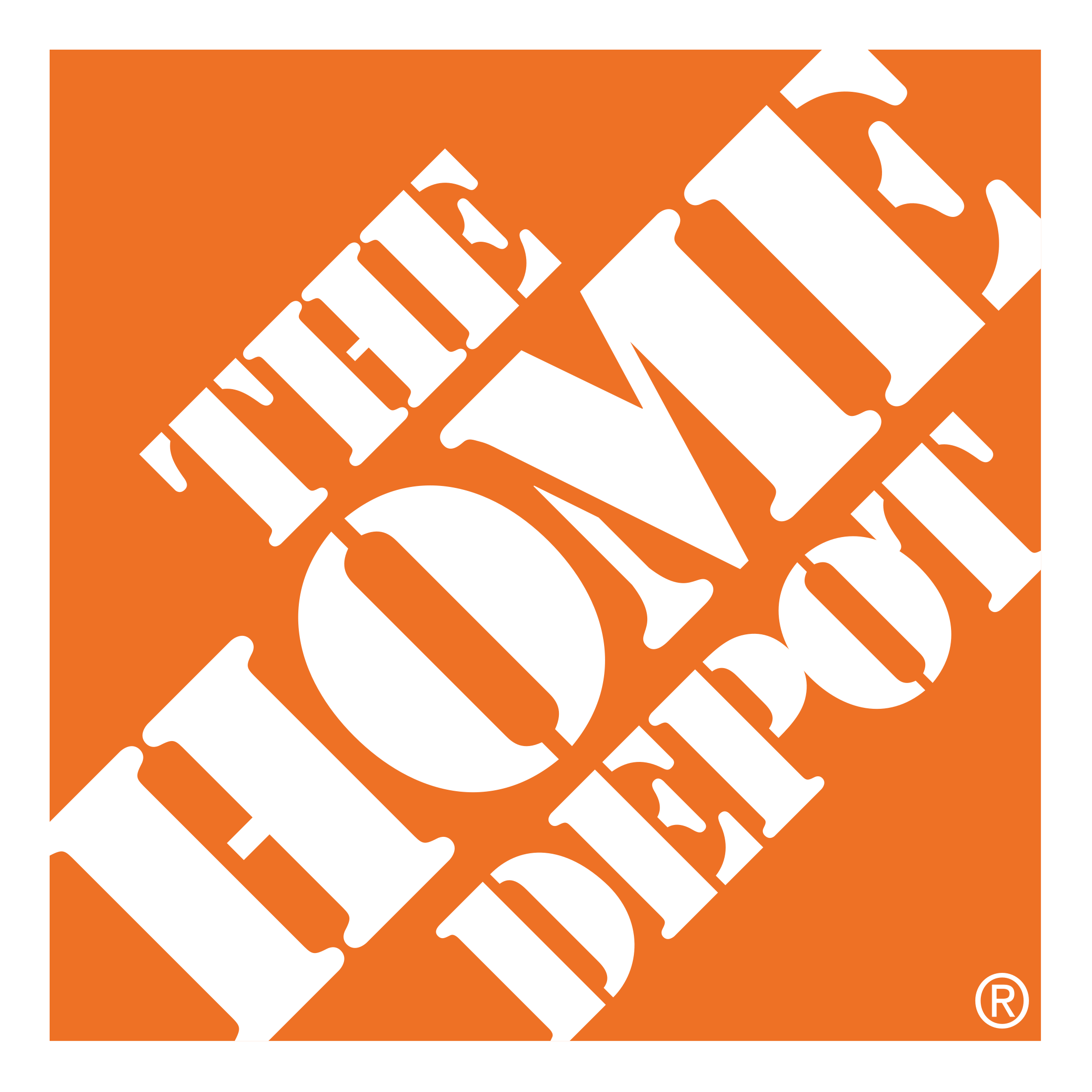Types of Respirator Masks

Published April 1, 2024
Masks have now become a more common, everyday item. They are useful in preventing the spread of disease, as well as helping with allergies and respiratory issues. You may have never heard the term "respirator" or "N95" before, or thought about how it works or differs from other types of face masks. But, there are some major differences to know.
Respirators are a type of personal protective equipment (PPE) worn on the face. They remove contaminants from the air using cartridges, filters or canisters. It is important to know which respirator type, certification and replacement cartridges you may need before you begin your project. Whether you’re taking on a major paint job, dealing with potentially dangerous chemicals like lead or doing daily tasks like sanding and woodworking, choosing the right type of mask will help you breathe easy.
There are many types of respirators, and choosing the correct model is essential for safety purposes. This guide will explain the different types of respirators available, including single-use and multi-use options. This guide will also help clarify the important differences between masks and respirators, outline different respirator certifications and uses and explain how replacement cartridges work. Read on to learn about the best mask for paint, mold and more. If you need to know which respirator is best for your DIY project, check out this respirator quick reference guide. For pro projects, check out this pro respirator quick reference guide.
Table of Contents
Differences Between Masks and Respirators
Types of Respirators
Understanding Respirator Ratings
Understanding Cartridges and Filters
Choosing the Right Size Respirator
How to Correctly Wear a Respirator
Differences Between Masks and Respirators
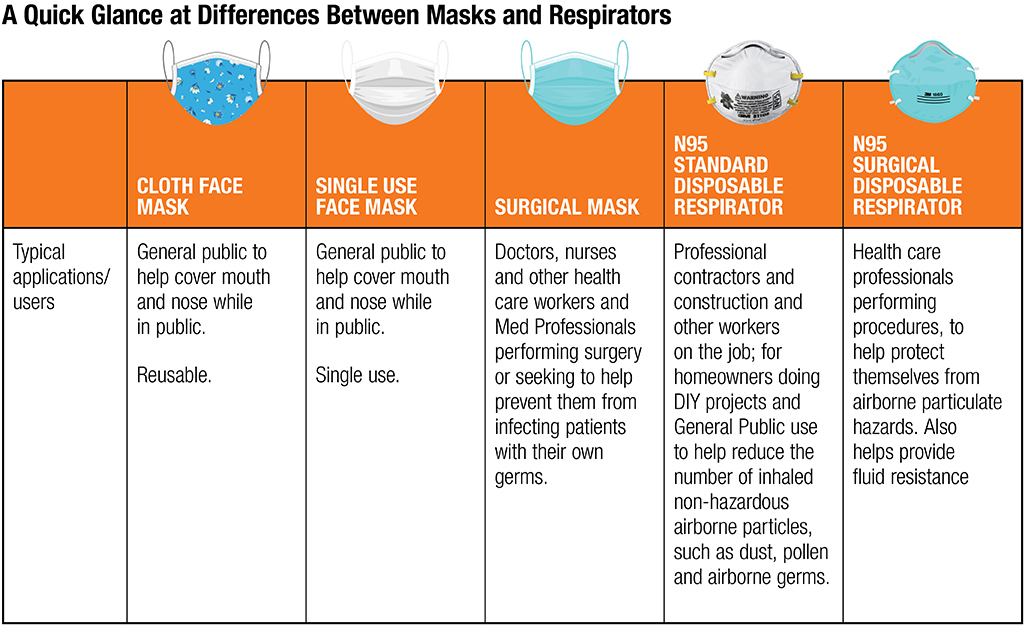
It is a common misconception that respirators and masks provide the same type of protection. Respirators can help protect you while you breathe in by filtering out small and even microscopic particles in the air, whereas cloth and single use masks are more about protecting those around you from large particle droplets as you breathe out, cough or sneeze.
Simple cloth face masks and coverings do not form a tight seal around your mouth and nose, limiting their ability to protect you from germs that may be in the air, since particles can leak in around the edges. However, these masks still help to slow the spread of airborne viruses because they offer a barrier that helps keep germs and large particle droplets from reaching other people as you talk, cough or sneeze.
Contrary to masks, respirators are tested and approved by the National Institute for Occupational Safety and Health (NIOSH), a division of the Centers for Disease Control. For NIOSH to approve a respirator, it must be able to capture and filter particles of varying sizes, including those so small you can't see them (like viruses and bacteria). Unlike cloth masks or surgical masks, respirators feature a tight seal to the face, and are made of a specially woven and statically charged fabric that filters 95 to 99.7 percent of all air particles as you breathe.
Paper dust masks are designed to reduce exposure to solid particles like dirt, silica and pollen. Dust masks are not National Institute for Occupational Safety and Health (NIOSH)-approved disposable filtering facepieces. Dust masks are not true respirators and do not offer protection against hazardous dust, gases or vapors. If the dust mask does not have a valve in the front and is made of paper instead of non-woven polypropylene fiber, it’s not a respirator. These simple masks can be worn during activities like mowing, gardening, sweeping and dusting.
True respirator masks such as N95 respirators are designed to protect the wearer from airborne particles and from liquid contaminating the face. They filter at least 95 percent of airborne particles such as dust, mists and fumes. These masks are approved by NIOSH because they effectively block out particulates down to .3 microns and large droplets won’t pass through the barrier. N95 respirators do not protect against oil-based particles.
If you want further info on the differences between respirators and masks, check out this guide.
Types of Respirators
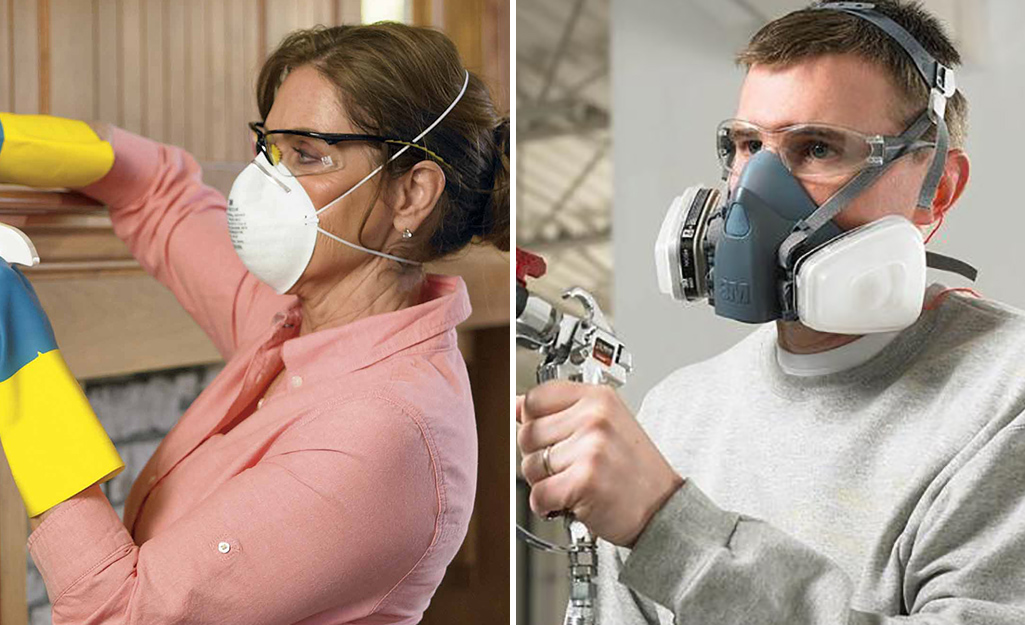
Disposable respirators:
- These are commonly referred to as particulate respirators and are sold in the half-face style. Disposable respirators are thrown away after use and are used for protection against airborne particles. There are two types of disposable respirators available: valved and non-valved.
- Valved respirators are designed to help prevent heat and moisture build-up inside the respirator, making them more comfortable to wear for extended periods of time. However, they only provide one-way protection to the wearer from outside particles; the valve does not prevent germs or virus particles from being exhaled through the valve. Valved respirators are available in the N95 (not oil resistant) and P95 (oil proof) ratings.
- Non-valved respirators provide two-way protection to both the wearer and those around the wearer, and are available in N95 (not oil resistant) and R95 (oil resistant) ratings.
Reusable respirators:
- If your work requires you to be in contaminated environments for prolonged periods, heavy-duty reusable respirators are a cost-effective and more comfortable alternative to disposable respirators. Reusable respirators are available in half and full face options to suit a variety of needs and projects, and feature interchangeable cartridges and filters.
- Reusable respirators can last a long time if properly cared for. Respirators should be cleaned at the end of each day in use, according to manufacturer instructions. Do not clean your reusable respirator with solvents as this may degrade respirator components and reduce effectiveness. Before each use, be sure to inspect your respirator to ensure good operating condition. Check the facepiece, plastic parts, and exhalation valve seat for cracks, tears and dirt. Be certain that the facepiece, especially face seal area, is not distorted, and make sure that head straps are intact and have good elasticity.
Understanding Respirator Ratings
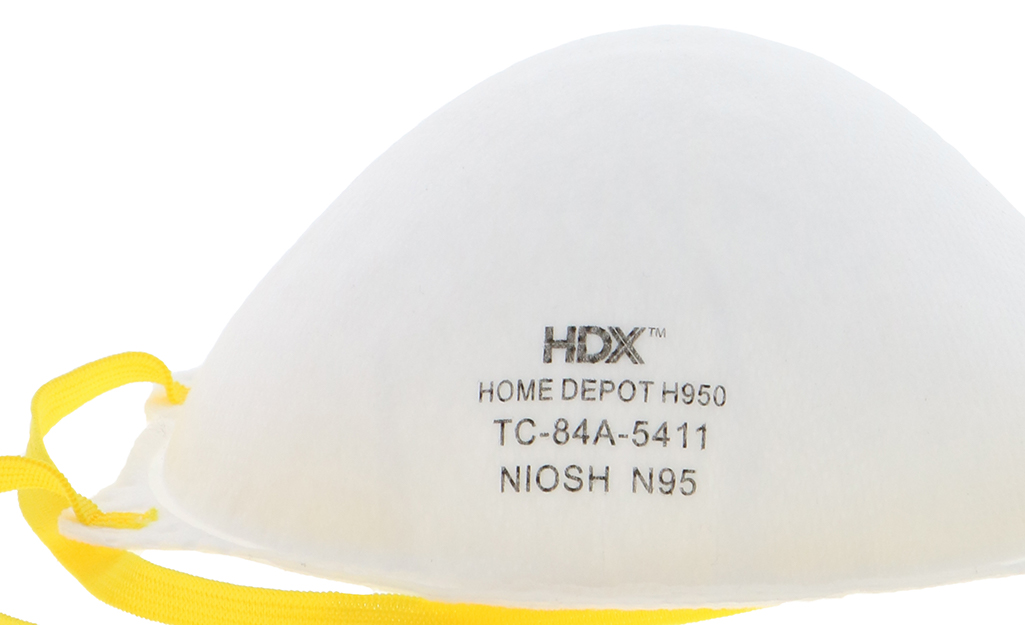
Unlike regular masks, respirators are rated by NIOSH, the National Institute for Occupational Safety and Health, a division of the Centers for Disease Control (CDC). Respirators are classified as N (Not Oil Resistant), R (Oil Resistant), or P (Oil Proof), and the associated number (95, 99, 100) represents the percentage of airborne particles that mask is able to remove fom the air.
N Ratings = Not Oil Resistant: For protection against dust, mists and fumes that do not contain oil aerosols.
- N95 filters at least 95 percent of airborne particles
- N99 filters at least 99 percent of airborne particles
- N100 filters at least 99.7 percent of airborne particles
R Ratings = Oil Resistant: For protection against dust, mists, fumes and occasional oil particle exposure. When using R-rated filters in oil-filled environments, you should only use the respirator for 8 hours at a time. Examples of oil particles include lubricants, cutting fluids, glycerine, some pesticides and some solvents.
- R95 filters at least 95 percent of airborne particles
P Ratings = Oil Proof. For protection against oil-based and non-oil based particles. Examples of oil particles include lubricants, cutting fluids, glycerine, some pesticides, and some solvents.
- P95 filters at least 95 percent of airborne particles
- P99 filters at least 99 percent of airborne particles
- P100 filters at least 99.7 percent of airborne particles
Safety Tip: Mold and asbestos applications require a P100 rating.
Understanding Cartridges and Filters
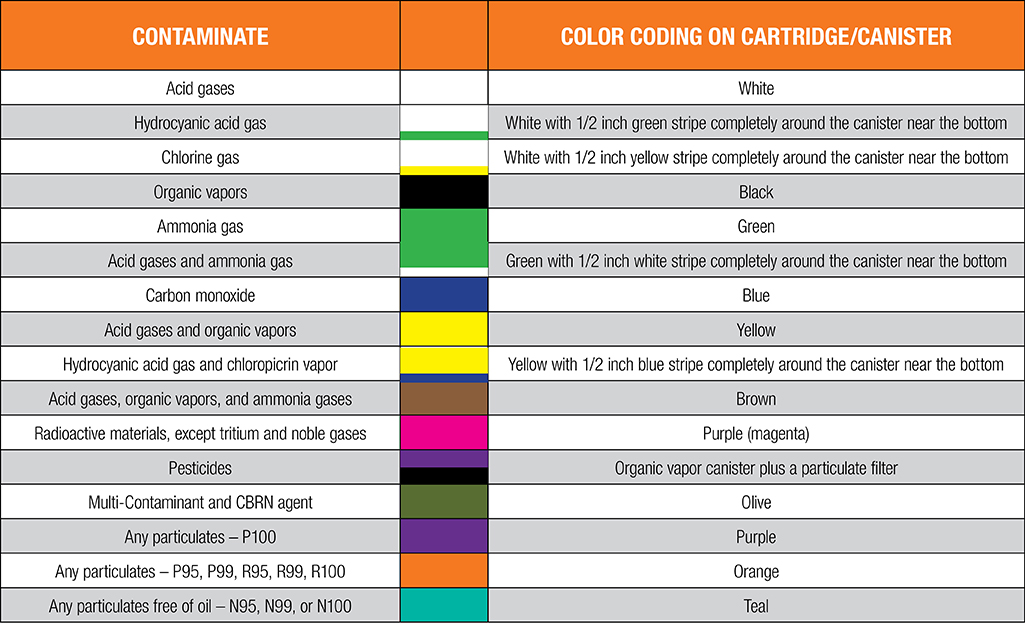
Basic dust masks and one-time use respirators for things like lead abatement are simple to use. The packaging will typically indicate what these respirators are for, and they do not require replacement cartridges. More powerful half-mask respirators and full-face respirators are often fitted with removable, replaceable cartridges to provide the required protection. Most models will tell you what they’re designed for right on the packaging, but a color-coded system implemented by OSHA makes finding the right cartridge simple.
The type of replacement cartridge and filter you need largely depends on your particular working environment and individual requirements. There are four aspects to consider when purchasing respirator cartridges and filters: exposure to Airborne Particles, Organic Vapors vs. Nuisance Level Organic Vapors and Acid Gases.
- Airborne Particulates include dust, pollen, smoke, dirt and liquid contaminants.
- Organic Vapors typically refer to liquids that are petroleum-based and evaporate quickly, such as gasoline, paint thinners, urethanes and solvent-based epoxy. You may see a respirator cartridge rated for Nuisance Level Organic Vapors; this is not the same certification as Organic Vapors. If your work-related contaminants are not above OSHA’s permissible exposure limits (PEL), they are considered nuisance level - think organic fumes from livestock, landfills, rotten organic matter, etc.
- Acid Gases include vapors from potentially harmful chemicals such as chlorine, hydrogen chloride, sulfur dioxide and more.
There are also combination cartridges and solutions if your project involves exposure to both acid gases and organic vapors.
Be sure to determine what type of filter you will need for your project before purchasing. Most cartridges follow OSHA's color coding system as outlined below:
- Green filters protect you from ammonia gases.
- White filters protect you from acid gases.
- Black filters protect you from organic vapors like solvents in paint and gasoline.
- Blue filters provide protection against carbon monoxide.
- Yellow filters protect against acid gases and organic vapors.
- Teal filters protect you from any particulates free of oil (N95, N99 or N100).
- Orange filters protect you from any particulates (P95, P99, R95, R99 or R100).
- Purple filters protect you from any particulates (P100).
New respirators may or may not come with the appropriate cartridges. Check before buying and ensure you get the right type of cartridge for the job.
Choosing the Right Size Respirator
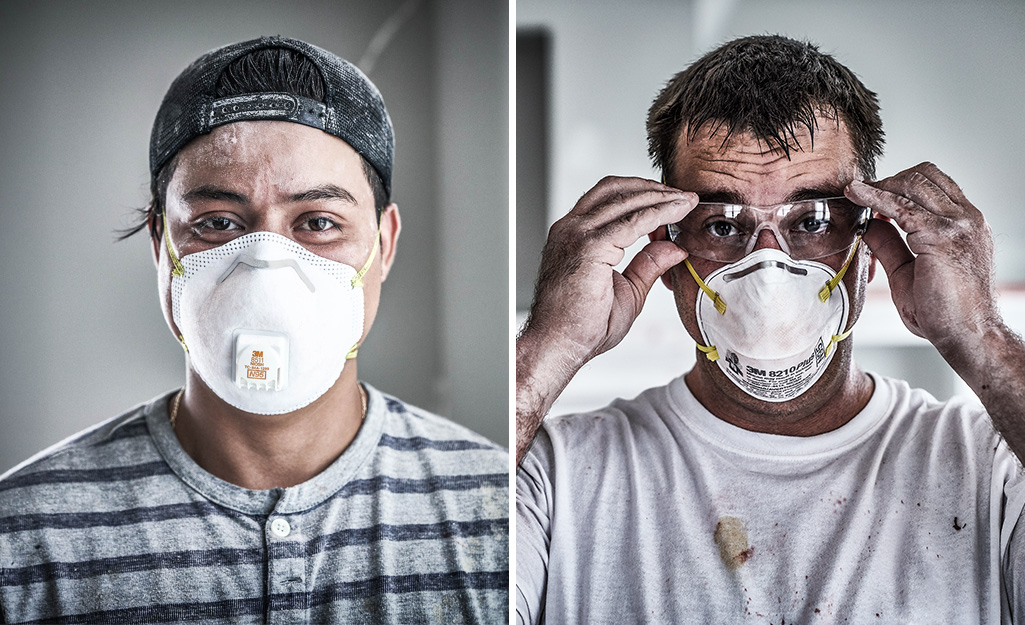
Choosing the right respirator for your task or work environment is essential. If your respirator is not the right size for your face, it won’t provide adequate protection, even if you’re using a heavy-duty full-face model. Use these tips to pick a respirator that’s the right size so you get the maximum amount of protection possible:
- Check that the respirator covers both your nose and mouth when positioned properly.
- Ensure that you’ve got a secure fit. A loose-fitting respirator that moves around on your face won’t provide the ideal amount of protection.
- Consider an adjustable respirator. Simple adjustments can provide a more comfortable and effective fit.
Still confused about which respirator might fit you? Try a size medium respirator first. About 80 percent of the adult population can effectively wear a medium respirator.
How to Correctly Wear a Respirator
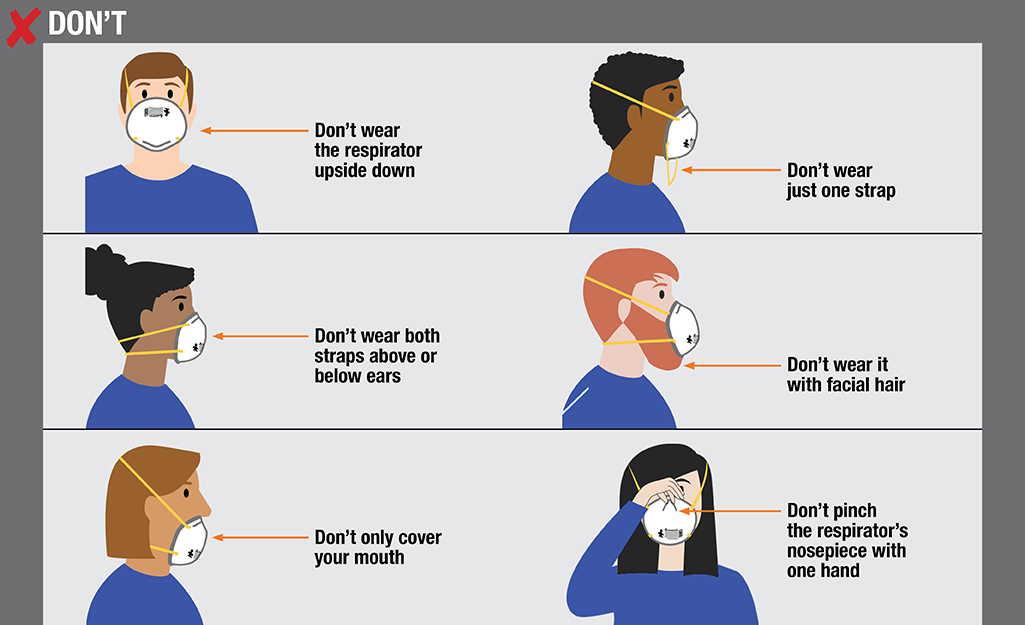
DO's:
- Make sure the respirator's metal nose clip is on top to help achieve a secure seal and fit.
- The respirator must cover your nose and mouth.
- Make sure to use both straps of the respirator, with the upper strap positioned on the crown of the head, and the lower strap positioned below the ears.
- Use your fingertips to mold the nose clip to the shape of your nose.
- Always perform a seal check to ensure you have a proper seal by placing both hands completely over the respirator and inhaling sharply. A negative pressure should be felt inside the respirator. If air leaks around the nose, readjust the nose piece. If air leaks at the respirator edges, work the straps back along the sides of you head. If you cannot get a secure seal, look for another respirator model that fits you correctly.
DONT'S:
- Try to avoid wearing a mask with facial hair. Beards, long mustaches and even stubble will likely cause leaks into the respirator.
- Don't pinch the respirator's nosepiece with one hand, use both hands. The nose clip should follow the curve of your nose and cheeks.
- Don't wear the respirator upside down. If the nose clip is at your chin, it's upside down and the respirator won't make a tight seal to your face.
- Don't wear just one strap, wear both, otherwise there won't be a tight seal and fit.
- Don't only cover your mouth, cover your nose too. If you only cover your mouth, then you risk breathing in hazardous particles through your nose.
When to Change Your Respirator
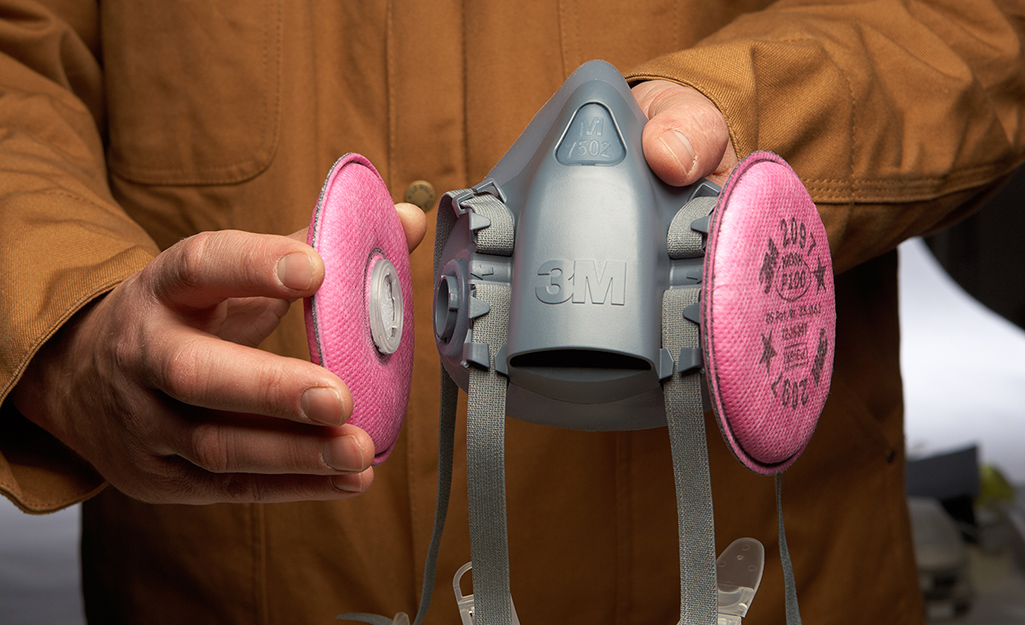
If you experience any of the 3D's (Dirty, Damaged, Difficult to Breathe Through) while using your respirator, go to a non-contaminated area and replace the respirator (if disposable) or change the filters (if reusable).
For reusable respirators, establish a cartridge/filter change schedule by using a service life calculator or using common change schedules based on substance-specific standards as defined by OSHA. If at any time you detect a smell, taste or irritation from the contaminants, leave the contaminated area immediately, replace the cartridges and perform a seal check before reentering the hazardous area. In environments containing oily aerosols, replace filter according to manufacturer instructions.
If you need even more info on certain respirator masks, check out this pro quick reference guide.
Some other respirator changing tips include:
- Use a change schedule to know when to replace cartridges.
- Establish a change schedule by using a service life calculator such as 3M.com/ServiceLife or using common change schedules based on substance-specific standards as defined by OSHA.
- However, if at any time you detect a smell, taste or irritation from the contaminants, leave the contaminated area immediately, replace the cartridges and perform a seal check before entering hazardous area again.
- In environments containing oily aerosols, such as a P series: Replace filter according to manufacturer (3M recommends 30 days or 40 hours use, whichever comes first).
The Home Depot carries an assortment of PPE equipment. Get the right protective gear to get your project done safely. Use The Home Depot mobile app to order what you need for delivery or curbside pickup, or to find products fast with image search.











